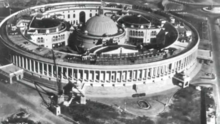The Parliament House (Hindi: Sansad Bhavan, transl. Parliament Building) in New Delhi is the seat of the Parliament of India. At a distance of 750 meters from Rashtrapati Bhavan, it is located on Sansad Marg which crosses the Central Vista and is surrounded by the India Gate, war memorial, prime minister’s office and residence, ministerial buildings and other administrative units of Indian government. It houses the Lok Sabha and the Rajya Sabha which represent lower and upper houses respectively in India’s bicameral parliament.
The building was designed by the British architects Sir Edwin Lutyens and Sir Herbert Baker and was constructed between 1921 and 1927. It was opened in January 1927 as the seat of the Imperial Legislative Council. Following the end of British rule in India, it was taken over by the Constituent Assembly, and then by the Indian Parliament once India’s Constitution came into force in 1950.
A new building to house Parliament is under construction directly opposite the current building as part of the Indian government’s Central Vista Redevelopment Project.
History

The circular House of Parliament in New Delhi, home of the Central Legislative Assembly
Originally called the House of Parliament, it was designed by the British architects Sir Edwin Lutyens and Sir Herbert Baker in 1912-1913 as part of their wider mandate to construct a new administrative capital city for British India. Construction of the Parliament House began in 1921 and it was completed in 1927.
The foundation stone was laid by HRH Prince Arthur, Duke of Connaught and Strathearn, in February, 1921. It took five years to complete the building. On January 18, 1927, Sir Bhupendra Nath Mitra, Member of the Governor-General’s Executive Council, in charge of the Department of Industries and Labour, invited Lord Irwin Viceroy of India to open the building. The third session of Central Legislative Assembly was held in this house on 19 January 1927.
Two floors were added to the structure in 1956 due to a demand for more space.
The Parliament Museum, opened in 2006, stands next to the Parliament House in the building of the Parliamentary Library.
Description
The perimeter of the building is circular, with 144 columns on the outside. At the centre of the building is the circular Central Chamber, and surrounding this Chamber are three semicircular halls that were constructed for the sessions of the Chamber of Princes (now used as the Library Hall), the State Council (now used for the Rajya Sabha), and the Central Legislative Assembly (now used for the Lok Sabha). The building is surrounded by large gardens and the perimeter is fenced off by sandstone railings (jali).
Some sources speculate that the design of the building was inspired by the Chausath Yogini temple in Morena.
The current building is planned to be converted into a Museum of Democracy after the new Parliament House is operational.
New parliament building
Background
Proposals for a new parliament building to replace Parliament House emerged in the early 2010s on account of stability concerns with older structure. A committee to suggest several alternatives to the current building had been set up by then-Speaker Mira Kumar in 2012.
Commencement
The Indian government in 2019 launched the Central Vista Redevelopment Project, with the construction of a new parliament building as a part, alongside other projects in New Delhi, including revamping Rajpath, making a new office and residence for the Indian prime minister, and combining all ministerial buildings in a single central secretariat.
The groundbreaking ceremony for the new building was held in October 2020 and the foundation stone was laid on 10 December 2020.
Incidents
2001 terror attack
On 13 December 2001, the Parliament House was attacked by five Lashkar-e-Taiba and Jaish-e-Mohammed terrorists. In addition to all the attackers, six military personnel and one civilian were killed.
Gallery
-

Lord Mountbatten addressing the Chamber of Princes as Viceroy in 1947.
-

A Constituent Assembly of India meeting in 1950.
-

Jawaharlal Nehru addressing the constituent assembly in 1946.
-

Indian Prime Minister Morarji Desai listens to U.S President Jimmy Carter as he addresses the Indian Parliament House in 1978.
-

U.S President Barack Obama addressing Joint Session of the Parliament in 2010.
